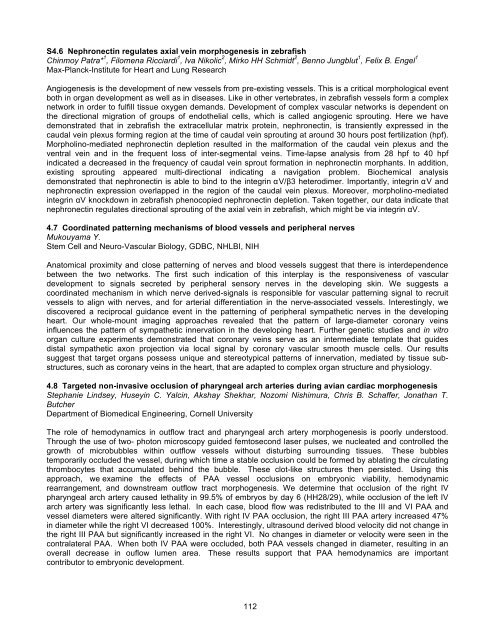Abstract Book Cover - Weinstein 2012 - University of Chicago
Abstract Book Cover - Weinstein 2012 - University of Chicago
Abstract Book Cover - Weinstein 2012 - University of Chicago
You also want an ePaper? Increase the reach of your titles
YUMPU automatically turns print PDFs into web optimized ePapers that Google loves.
S4.6 Nephronectin regulates axial vein morphogenesis in zebrafish<br />
Chinmoy Patra* 1 , Filomena Ricciardi 1 , Iva Nikolic 2 , Mirko HH Schmidt 2 , Benno Jungblut 1 , Felix B. Engel 1<br />
Max-Planck-Institute for Heart and Lung Research<br />
Angiogenesis is the development <strong>of</strong> new vessels from pre-existing vessels. This is a critical morphological event<br />
both in organ development as well as in diseases. Like in other vertebrates, in zebrafish vessels form a complex<br />
network in order to fulfill tissue oxygen demands. Development <strong>of</strong> complex vascular networks is dependent on<br />
the directional migration <strong>of</strong> groups <strong>of</strong> endothelial cells, which is called angiogenic sprouting. Here we have<br />
demonstrated that in zebrafish the extracellular matrix protein, nephronectin, is transiently expressed in the<br />
caudal vein plexus forming region at the time <strong>of</strong> caudal vein sprouting at around 30 hours post fertilization (hpf).<br />
Morpholino-mediated nephronectin depletion resulted in the malformation <strong>of</strong> the caudal vein plexus and the<br />
ventral vein and in the frequent loss <strong>of</strong> inter-segmental veins. Time-lapse analysis from 28 hpf to 40 hpf<br />
indicated a decreased in the frequency <strong>of</strong> caudal vein sprout formation in nephronectin morphants. In addition,<br />
existing sprouting appeared multi-directional indicating a navigation problem. Biochemical analysis<br />
demonstrated that nephronectin is able to bind to the integrin αV/β3 heterodimer. Importantly, integrin αV and<br />
nephronectin expression overlapped in the region <strong>of</strong> the caudal vein plexus. Moreover, morpholino-mediated<br />
integrin αV knockdown in zebrafish phenocopied nephronectin depletion. Taken together, our data indicate that<br />
nephronectin regulates directional sprouting <strong>of</strong> the axial vein in zebrafish, which might be via integrin αV.<br />
4.7 Coordinated patterning mechanisms <strong>of</strong> blood vessels and peripheral nerves<br />
Mukouyama Y.<br />
Stem Cell and Neuro-Vascular Biology, GDBC, NHLBI, NIH<br />
Anatomical proximity and close patterning <strong>of</strong> nerves and blood vessels suggest that there is interdependence<br />
between the two networks. The first such indication <strong>of</strong> this interplay is the responsiveness <strong>of</strong> vascular<br />
development to signals secreted by peripheral sensory nerves in the developing skin. We suggests a<br />
coordinated mechanism in which nerve derived-signals is responsible for vascular patterning signal to recruit<br />
vessels to align with nerves, and for arterial differentiation in the nerve-associated vessels. Interestingly, we<br />
discovered a reciprocal guidance event in the patterning <strong>of</strong> peripheral sympathetic nerves in the developing<br />
heart. Our whole-mount imaging approaches revealed that the pattern <strong>of</strong> large-diameter coronary veins<br />
influences the pattern <strong>of</strong> sympathetic innervation in the developing heart. Further genetic studies and in vitro<br />
organ culture experiments demonstrated that coronary veins serve as an intermediate template that guides<br />
distal sympathetic axon projection via local signal by coronary vascular smooth muscle cells. Our results<br />
suggest that target organs possess unique and stereotypical patterns <strong>of</strong> innervation, mediated by tissue substructures,<br />
such as coronary veins in the heart, that are adapted to complex organ structure and physiology.<br />
4.8 Targeted non-invasive occlusion <strong>of</strong> pharyngeal arch arteries during avian cardiac morphogenesis<br />
Stephanie Lindsey, Huseyin C. Yalcin, Akshay Shekhar, Nozomi Nishimura, Chris B. Schaffer, Jonathan T.<br />
Butcher<br />
Department <strong>of</strong> Biomedical Engineering, Cornell <strong>University</strong><br />
The role <strong>of</strong> hemodynamics in outflow tract and pharyngeal arch artery morphogenesis is poorly understood.<br />
Through the use <strong>of</strong> two- photon microscopy guided femtosecond laser pulses, we nucleated and controlled the<br />
growth <strong>of</strong> microbubbles within outflow vessels without disturbing surrounding tissues. These bubbles<br />
temporarily occluded the vessel, during which time a stable occlusion could be formed by ablating the circulating<br />
thrombocytes that accumulated behind the bubble. These clot-like structures then persisted. Using this<br />
approach, we examine the effects <strong>of</strong> PAA vessel occlusions on embryonic viability, hemodynamic<br />
rearrangement, and downstream outflow tract morphogenesis. We determine that occlusion <strong>of</strong> the right IV<br />
pharyngeal arch artery caused lethality in 99.5% <strong>of</strong> embryos by day 6 (HH28/29), while occlusion <strong>of</strong> the left IV<br />
arch artery was significantly less lethal. In each case, blood flow was redistributed to the III and VI PAA and<br />
vessel diameters were altered significantly. With right IV PAA occlusion, the right III PAA artery increased 47%<br />
in diameter while the right VI decreased 100%. Interestingly, ultrasound derived blood velocity did not change in<br />
the right III PAA but significantly increased in the right VI. No changes in diameter or velocity were seen in the<br />
contralateral PAA. When both IV PAA were occluded, both PAA vessels changed in diameter, resulting in an<br />
overall decrease in ouflow lumen area. These results support that PAA hemodynamics are important<br />
contributor to embryonic development.<br />
112


